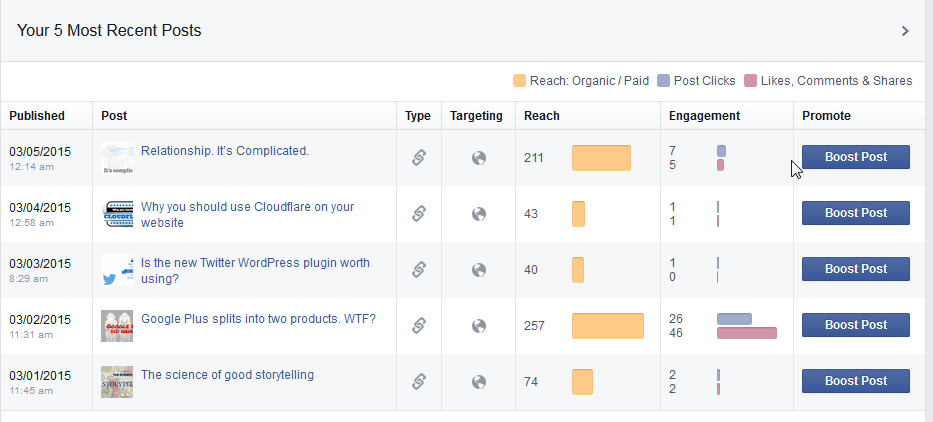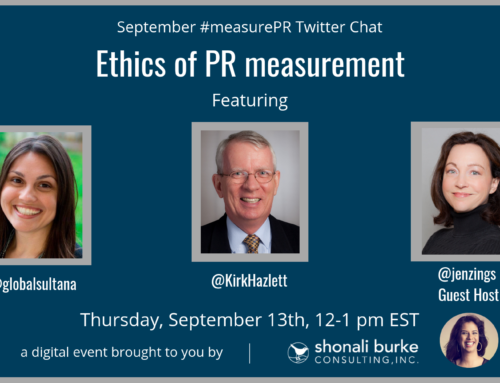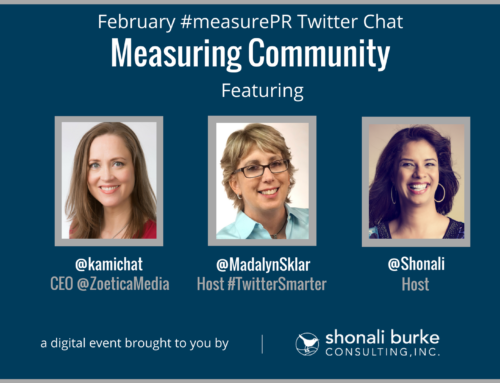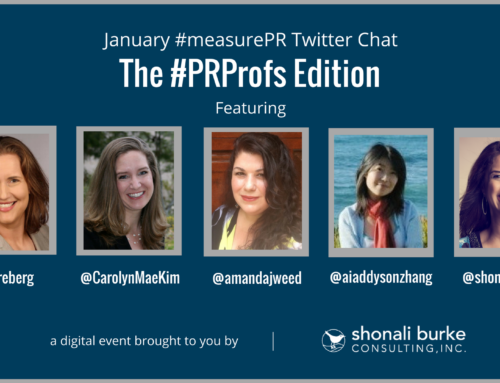“If you can’t measure it, you can’t manage it.” ~Peter Drucker
Odds are that you’ve heard someone say that PR can’t be quantified, or social media ROI can’t be measured, or that a media impression or social post generated an advertising value equivalent (AVE) of hundreds of thousands (or millions) of dollars. All of these statements are correct in their limited context, but are also misstatements meant to reconcile the difficulty of communications measurement.
When we think linearly about measuring the impact of PR, it is very difficult to quantify the impact of our actions (by “linearly” I mean to say that we work only with the measurements that are low-friction to procure).
You can’t properly attribute sales or awareness to communications using baseline analytics from Google or Facebook or Twitter.
Last touch attribution models discount all of the steps leading to a sale, and multi-touch attribution models are often constructed with enough assumptions to render them rather inaccurate (for more on the statistical challenges with multi-touch attribution read this). Most CMOs don’t even measure ROI for their marketing budgets, and marketers have a lot more resources compared to PR practitioners.
With this mindset, we may assume that the impact of PR to a business can’t be measured or that communications are quantified by superficial metrics. Recalling the Drucker quote at the beginning of this piece:
Capitulation to bad measurement is an admission that we cannot manage communications.
And I doubt there is anyone working in the PR profession that would concede that communications can’t be managed.
From a big picture perspective, most of us believe that we can measure almost anything. Our understanding of PR metrics needs a paradigm shift, though. And a lot of the writing about PR metrics is too obtuse, too broad, or too incorrect to apply to the real world. Even well-established agencies publish jargon-y white papers about metrics that qualify the quality and reach of a media placement rather than the impact to support the corporate goals.
“The biggest challenge in measurement overall is the allure of measuring what’s easy.” ~Sandra Fathi, Past President, PRSA NY
The image below is a screenshot of Facebook Analytics from my blog’s Facebook Page:
 You can see that some posts are more popular than others, some were clicked-through more than others, but it’s all empty calories. The whole page is set up to get you to spend money based on “ego” metrics. This provides a great example of cheap metrics that don’t inform you about how effectively you are contributing to corporate goals. These are metrics that Sandra Fathi terms “easy” in the quote above.
You can see that some posts are more popular than others, some were clicked-through more than others, but it’s all empty calories. The whole page is set up to get you to spend money based on “ego” metrics. This provides a great example of cheap metrics that don’t inform you about how effectively you are contributing to corporate goals. These are metrics that Sandra Fathi terms “easy” in the quote above.
So what is the alternative to this great-looking page of frictionless frivol?
What if we determine the metrics that we need rather than accept the measurements that are available? This is one of the key points from a PRSA talk given by Johna Burke, EVP of BurrellesLuce (note: this presentation was available as a webinar through PRSA, but sadly is no longer available). Burke suggests that our measurement blind spots are a product of undefined organizational roles and objectives and lack of creativity to measure what we want to measure.
What Burke suggests is that everyone in the organization needs to have clearly defined roles and that the responsibilities for each functional area should be clearly defined as well:
What specifically do we do?
What specifically do I do? How do I support what we do?
What specifically do they do? How do they support what we do?
In a #measurepr chat last year, participants vetted some of the issues stemming from lack of role definition:
A1. The result: PR is poorly integrated with the rest of marketing. Many don’t understand PR or its value. #measurepr
”” Eric Wittlake (@wittlake) January 7, 2014
After Wittlake’s answer, a conversation morphed into what PR is and isn’t. Should PR be tied to sales? Do media impressions have a loftier purpose than advertising or marketing? The debate and contentiousness stemmed from the fact that people have different opinions about how communications professionals should contribute to an organization.
That’s the brilliance of Burke’s first insight about organizational responsibilities.
Unless everyone understands their role, the roles of their compatriots, and the goals of the organization, it’s likely that PR, marketing, customer service, executives, and (name another functional group here) will have different understandings of their roles and responsibilities in the organization.
If you think your job is to get impressions and your CMO boss is tasked to drive sales, there’s a disconnect between your metrics and your expected end-state. By vetting this ahead of time, you address Wittlake’s point and quell the conversation that follows.
There’s also another familiar Burke whose five-step plan for PR management (ebook available for free on her website — conveniently located where your eyes are gazing now) outlines a process that is quite similar to Johna Burke. I recommend downloading it for a really pragmatic, straightforward point of view about PR measurement.
“Don’t settle on shiny new toys just because (someone else) is using them. Far too many organizations do that without thinking strategically of what they are trying to achieve… and then they’re disappointed with the results.” ~Shonali Burke, A Simple Yet Smart PR Measurement for The Rest of Us: A five-step plan that won’t break the bank
If your organizational responsibilities are clear, and you understand the big picture, then it’s time to find a meaningful measurement to gauge your progress. While it might be tempting to go on a three-month long vision quest to find the best analytics solution to provide useable data and an understanding of your life’s purpose, (Johna) Burke suggests something different: “engineering” metrics.
The example she gives is of a PR department tasked with building awareness around a brand. Partnering with customer service, they introduce “where did you hear about us?” into their customer calls to track how effectively media placement is impacting brand awareness.
The brilliance of a metric like this is that it tells you exactly what you want to know. Contrast that with The Ultimate Question (on a scale of 1-10 how likely are you to recommend X to your friends and family?) or long surveys with low-compliance, you can see that incorporating thoughtful interaction to customer touch points can give you really strong measurement of the customer life cycle.
This isn’t the only way that you can create relevant metrics:
*One of my favorite creative ways for tracking attribution are the use of promotional codes on radio commercials. Listeners use the code to get a discount, and the seller gains insight about the referral source. The same principle can be applied to isolate sources at most touch points.
*Digital content allows for unique measurement from basic segmentation options, to cookies, to supercookies, to canvas fingerprinting, and device identifiers.
*Analytics solutions can be very helpful, so long as they give you the information that you want. If you’re using their information as a barometer of what you should be measuring, this is when these “shiny toys” can be counterproductive.
By creating the metrics that you want rather than acquiescing to what is available, you can make your work much more effective.
“Measurement for measurement’s sake will have little impact on PR’s future as a key driver of business. In fact, it will most likely have the adverse effect.” ~Rebekah Iliff, AirPR
What I wanted to do in this piece was to introduce the idea that meaningful PR measurement is possible if done in a collaborative and thoughtful way. The ability to define roles and to “engineer” metrics may not be plausible in a lot of work environments because of the top-down support it requires and the transparency that it engenders. But it’s a great advantage for PR practitioners who can actually measure their effectiveness and use that information to optimize their resources.
I was joking in an email to Shonali that I felt like this post was a little redundant considering how she is one of the eminent figures in PR measurement. As proof, I found this excerpt from an interview that she did for the International Association of Business Communicators (IABC) a while back discussing PR measurement:
Question (to Shonali): What are your top 3 measurement tips?
1. Begin at the end (what you’re trying to achieve).
2. Measure what’s important (not everything is).
3. Don’t get stuck in measuring tools; make the tools work for you, not vice versa.
Since she said in 30 words what it took me 1400 to say, I’ll close by recommending that you subscribe to her newsletter where you’ll receive her insights about PR measurement and also receive recaps of #measurepr chats.








[…] Shonali Burke is with us on measurement and has three tips: […]
[…] Shonali Burke’s top three measurement tips are: […]
[…] they need into their process. Pioneers in this area include Johna Burke of BurrellesLuce and Shonali Burke (more on their insights here). Both Burkes encourage delineating corporate responsibilities and expectations, as well as finding […]
[…] Podcasts enable you to engineer meaningful metrics. […]
[…] Podcasts enable you to engineer meaningful metrics. […]
[…] Burke, EVP of BurrelesLuce shared a perspective in a recent PRSA talk that many businesses would be wise to heed: tactics like social media should have clear purpose and responsibilities, and businesses should […]
ggSolutions123 NP! That was from @leaderswest, though. :)
[…] How to Develop Meaningful PR Measurement […]
Jenae_Jones Yes, it was a great one from leaderswest! CBechervaise
CBechervaise shonali really an informative post!
Thanks for the somewhat shocking AdAge link, Shonali, which I’d never seen. (Re: 28 percent of marketers go with ‘gut instinct’ and they don’t practice what they preach as far as measuring/ROI)
gojohnab DEF. leaderswest
EmilyKantner bowden2bowden mmangen TYVM for sharing leaderswest guest #WUL post
jessicagsharp That’s a GREAT post from leaderswest isn’t it?
valuePR That’s a super post by leaderswest!
valuePR That’s a super post by leaderswest!
[…] Shonali Burke | How to Develop Meaningful PR Measurement. […]
I totally hear ya! What was purposed is not do nutty either. I actually just broke the necessary steps on my Instagram account in video format and I started with the very foundations discusses here. Always happy to connect with like minded folks. Keep up the great work!
Mrsdstahl Hi Sarah – what an awesome comment. I’m excited about what @gojohnab proposes because it is so simple, yet radical. But I suspect that even if a lot of people understood how they could engineer more meaningful measurement into their work, that the accountability is frightening. That may just be the cynic in me talking, but superfluous, easy metrics are assuring in a way. Really appreciate your insight – it made me think about it some more. Cheers!
.leaderswest aww, thank you very much:) I’m going with ‘genius’ over creepy based on your article & tweets:) shonali #imho
.gojohnab In all seriousness, that webinar was rich and I wish PRSA would post it again. Far better than most – you rock. The end. shonali
Hey shonali, I think gojohnab is on to the fact that I’m her creepy fan. :)
Great article Jim! Totally captured by the title “https://shonaliburke.com/2015/03/11/develop-meaningful-pr-measurement/” Because meaningful measurement is truly the foundations of truly understanding if any companies social efforts are worth the effort. And if there not, measurement allows us to identify the problems so that our efforts are not wasted. Great mention to “ego” metrics, I like to call them “vanity” but the point is still the same. Analyzing data is so much more than # of likes and pointed decisions will only emerge when we dive deep into data. As you mentioned, we cant measure goals reached with baseline alone. Any who…I’m totally intrigued by what data reveals and totally Loved where you went with this. Enjoy your day! Sarah
shonali Burke sandwich or ‘between the Burke’s’ (which could be a good soap opera title) as dfriez used last week:) thanks 4 sharing!
MeghanMBiro VoxOptima brokeblokeblogs BrennerMichael trle Many thanks for sharing leaderswest guest #WUL post